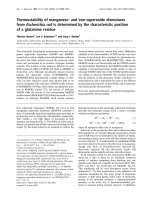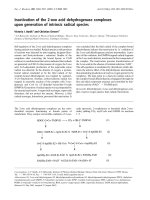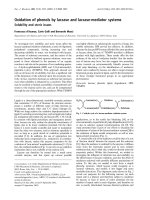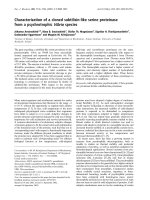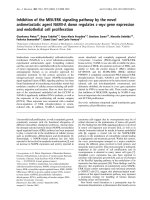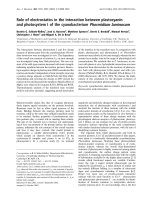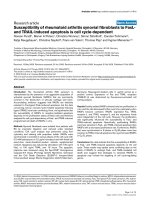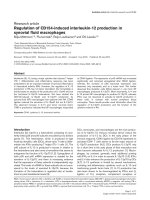Báo cáo y học: "Utility of synovial biopsy" pps
Bạn đang xem bản rút gọn của tài liệu. Xem và tải ngay bản đầy đủ của tài liệu tại đây (1.43 MB, 6 trang )
Available online />Page 1 of 6
(page number not for citation purposes)
Abstract
Synovial biopsies, gained either by blind needle biopsy or minimally
invasive arthroscopy, offer additional information in certain clinical
situations where routine assessment has not permitted a certain
diagnosis. In research settings, synovial histology and modern
applications of molecular biology increase our insight into patho-
genesis and enable responses to treatment with new therapeutic
agents to be assessed directly at the pathophysiological level. This
review focuses on the diagnostic usefulness of synovial biopsies in
the light of actual developments.
Introduction
The possibility of utilizing information from synovial biopsies
as a diagnostic and research tool has attracted substantial
interest amongst rheumatologists in the past few decades
[1,2]. Its importance is likely to further increase in the near
future for a number of reasons. First, early diagnosis and
immediate initiation of disease-modifying antirheumatic drug
(DMARD) therapy in rheumatoid arthritis was shown to
significantly improve outcome parameters [3]. Early rheuma-
toid arthritis (RA), however, may not be unequivocally diag-
nosed in all cases, based on clinical and serological criteria
alone [4]. Histological analysis of synovial biopsies may prove
to be valuable in establishing an early diagnosis [5].
Furthermore, in addition to traditional parameters, histology
and molecular markers out of synovial tissue might be useful
to identify patients with poor outcome [6], provide sensitive
means of assessing response to treatment [7-10], or identify
those patients who most likely will respond to a certain
treatment option [11]. Second, with the actual and upcoming
possibilities of molecular medicine, synovial tissue is needed
to conduct basic research to improve our understanding of
mechanisms of action of modern biological agents and to
develop new therapeutic strategies [12]. Third, images of
modern non-invasive tools such as magnetic resonance
imaging, single photon emission computed tomography, high
resolution duplex sonography, and positron emission com-
puted tomography may be correlated to macroscopic and
histological changes using minimally invasive procedures
such as needle arthroscopy, thereby providing a scientific
basis for future improvements [13]. Fourth, in cases of un-
differentiated arthritis, visualization of the affected joint and
sampling of synovial tissue can facilitate the diagnostic
process [14].
Thus, obtaining a synovial biopsy may likely be an increasingly
important tool in the future, especially from joints that are
involved in the early disease course, such as finger joints.
Complementary to excellent previous reviews of the topic
[1,2], this review will focus on the diagnostic usage and
potential of synovial biopsies.
Synovial sampling
Methods of synovial sampling
Synovial biopsies can be taken by arthroscopy (Figure 1),
using blind needle techniques, or ultrasonographic guidance.
The major draw-back of blind needle biopsy is the potential
for sampling errors. In general, histological results are the
same, regardless of the method used [15]. There is con-
troversy, however, if biopsies from sites adjacent to cartilage,
which cannot be easily biopsied by a blind procedure, display
a higher degree of inflammatory changes, thereby under-
estimating the amount of inflammation and favouring optical
guidance for targeted biopsy [15-18]. Thus, knowledge about
the exact anatomical position of the biopsy may well be
important. Arguments in favour of the use of closed needle
biopsy are the substantially reduced costs as opposed to
arthroscopic procedures and the need for only one rather
than two portals into the joint. Current instrumentation and
techniques of diagnostic arthroscopy have recently been
Review
Utility of synovial biopsy
Stefan Vordenbäumen
1
, Leo AB Joosten
2
, Johannes Friemann
3
, Matthias Schneider
1
and Benedikt Ostendorf
1
1
Department of Endocrinology, Diabetology, and Rheumatology, Heinrich Heine University, 40225 Düsseldorf, Germany
2
Department of Medicine, Radboud University Nijmegen Medical Centre, P.O. Box 9101, 6500 HB Nijmegen, The Netherlands
3
Institute for Pathology, Märkische Clinics, 58151 Lüdenscheid, Germany
Corresponding author: Benedikt Ostendorf,
Published: 23 November 2009 Arthritis Research & Therapy 2009, 11:256 (doi:10.1186/ar2847)
This article is online at />© 2009 BioMed Central Ltd
DAS = Disease Activity Score; RA = rheumatoid arthritis.
Arthritis Research & Therapy Vol 11 No 6 Vordenbäumen et al.
Page 2 of 6
(page number not for citation purposes)
reviewed elsewhere [19]. Ultrasonographic guidance of
synovial biopsy is a promising new technique that allows
sampling of large and small joints as well as tendon sheaths
under indirect visualization requiring only one portal [20-22].
Indications in clinical practice
RA can generally be diagnosed based on clinical, serological,
and radiological criteria alone and, for clinical routine purposes,
does not necessitate a biopsy [1,23]. Outside of research
settings, a synovial biopsy can be justified in cases of unclear
arthritis [14,23,24].
Whipple disease can be diagnosed by histological evaluation
of involved organs [25]. If suspected, tuberculous arthritis
should lead to synovial biopsy, especially if synovial culture is
negative for acid-fast bacilli, because super infections with
other organisms may inhibit growth of acid-fast bacilli in
synovial fluid culture [26,27]. Non-infectious granulomatous
states, such as sarcoidosis, affecting a joint can be diag-
nosed when typical histology of the involved synovia is
demonstrated [28]. Malignant cells are sometimes observed
in joint aspiration, but visualization using arthroscopy and
histological evaluation should be undertaken, especially if the
neoplastic process is a metastasis and the primary tumour is
not known [29]. Leukemic arthritis may precede systemic
onset and malignant cells are not always visible in joint
aspiration, especially if hemarthros is present. Synovial biopsy
may demonstrate malignant cell infiltrates in the synovia [30].
Pigmented villonodular synovitis is a differential diagnosis in
mono- or oligoarticular arthritis and biopsy is required for
diagnosis [31]. Pigment deposition as in amyloidosis [32],
ochronosis [33], and hemochromatosis [34] can be diag-
nosed by special staining of the synovial biopsy. Infectious
arthritis may be diagnosed by culturing of biopsy specimen.
The detection of certain infections with pathogens like
Neisseria, Chlamydia, fungi [14,35], and especially infections
with uncommon pathogens such as Varicella zoster virus may
require a biopsy for definitive diagnosis [36]. Diagnosis of
infectious arthritis based on the specific detection of nucleic
acids is also an option, even though results should be
interpreted cautiously, as they are not always of pathogenetic
importance [37]. Deposits of gout and pseudogout can be
detected in synovial tissue [38,39] and are of diagnostic
value in differentiating mass lesions due to crystals from
malignant causes [39].
In rheumatic diseases, arthroscopy may also be indicated for
therapeutic purposes - as in joint lavage of septic arthritis and
rheumatoid arthritis - to remove crystal deposits [40], or for
minimally invasive synovectomy [41]. Furthermore, there are
numerous traumatologic indications for minimally invasive
arthroscopy of joints, such as removal of loose bodies and
fragments of cartilage, but these are beyond the scope of this
review.
Complications
Synovial biopsy is generally regarded as a safe procedure
[1,2]. In a large multicenter survey of over 15,000 arthros-
copies performed by rheumatologists, hemarthros was
reported in 0.9%, wound and joint infection in 0.1%, and deep
vein thrombosis in 0.2% of cases [42]. Complication rates in
blind biopsies are equally low, with no major complications
reported in over 800 blind biopsies in one series [1]. Minimally
invasive joint arthroscopies and blind biopsy may thus safely
be performed in an outpatient setting [17].
Macroscopic assessment of the synovial
membrane
Fiberoptical visualization of joints permits assessment of
bone, cartilage, synovia, and, where present, menisci and
ligaments. Cartilage may be intact, impaired or destroyed;
bony structures may additionally display erosions. The
synovia can be assessed as to its vasculature, proliferation,
presence of synovitis, and thickness (Figure 2). Furthermore,
the presence of chondromatosis and fibrosis can be
detected. By determining these aspects, active and chronic
inflammatory processes and alterations can be differentiated.
Figure 1
Set for mini-arthroscopy (upper) and fiberoptic instrumentation (needle
arthroscopy, diameter 1 mm; lower).
Scoring systems for the knee [17] and for metacarpo-
phalangeal joints take into account the above mentioned
alterations [43]. Macroscopic findings were shown to
correlate with histological and clinical parameters [17,44], as
well as magnetic resonance imaging [13] in rheumatoid
arthritis. So far, however, there has been no widely accepted
method for the description or scoring of macroscopic
changes and the suggested scoring systems have not been
validated sufficiently. Furthermore, macroscopic features may
not predict histological changes in individual patients [19].
Macroscopic aspects might help to differentiate different
causes of arthritis, such as distinct vascularity patterns with
straight vessels in RA as opposed to tortuous vessels or a
mixed pattern in spondyloarthritis, reactive arthritis, and
psoriatic arthritis [17,45,46]. These changes, however, are
not sufficiently consistent to permit a diagnosis in individual
patients [45,46]. It is noteworthy that the pattern of
vascularity might be valuable to stratify RA patients into risk
groups with a worse outcome for those who display a straight
vascularity pattern [47]. Further research is needed to deter-
mine the value of macroscopical scoring in arthritis and to
establish standardized scoring systems.
Potential of histopathology derived from
synovial tissue
Histological and molecular markers of inflammation in synovial
tissue correlate with disease activity [48,49], display res-
ponse to treatment [7,8] and permit estimations concerning
disease outcome [6,50] in RA. Intimal layer thickness, blood
vessel proliferation and especially macrophage cell infiltrates
have been pointed out as such synovial markers of disease
activity [51]. Histological assessment of synovial biopsies in
arthritic patients includes the determination of the thickness
of the synovial layer, the density and composition of the
cellular infiltrate, the presence of tumourous structures, and
the presence of bacteria or crystals [52]. The vascularity of
the synovial membrane can also be assessed as and aid in
the differential diagnosis, especially between spondylo-
arthritis and RA [53]. A validated and widely used semi-
quantitative scoring system that focuses on RA takes into
account the degree of subintimal cellular infiltration and
Available online />Page 3 of 6
(page number not for citation purposes)
Figure 2
Intraarticular images of metacarpophalangeal II joints from patients with rheumatoid arthritis. Normal cartilage and synovial membrane after
methotrexate treatment (upper left), cartilage damage and starting erosions (upper right), severe synovial proliferation (lower left), and increased
vascularity (lower right).
intimal layer thickness [49]. A more recently introduced
synovitis score additionally requires the quantification of
leukocyte infiltrates and permits the differentiation of inflam-
mation into high-grade and low-grade synovitis in an attempt
to distinguish between different subsets of arthritis, such as
osteoarthritis (low-grade) and RA (high-grade) based on
histological criteria alone [54]. Computer-assisted image
analysis is constantly improving and nowadays permits a
rapid and reliable analysis of tissue sections [55-57].
Histological data have been used to differentiate between
patient groups with different kinds of arthritis in the past [58].
Increased vascularity [53] or the expression of distinct
adhesion molecules [59] may differentiate between
spondyloarthritis and RA, or the cellular composition of the
infiltrate between psoriatic arthritis and RA [53]. Furthermore,
the correct diagnosis in patients with undifferentiated arthritis,
especially the distinction between patients with RA as
opposed to other pathologies, might be facilitated by increased
presence of certain cell subsets [60], molecular markers [5], or
the detection of specific peptides or protein complexes. Intra-
cellular citrullinated proteins and major histocompatibility
complex class II/cartilage glycoprotein complexes detected by
immunostaining of synovial biopsies, for instance, were
demonstrated to be specific, albeit insensitive for RA [61-63]
and might be a useful adjunct to conventional parameters in
the diagnostic workup of patients with undifferentiated
arthritis [64] or in distinguishing those with spondyloarthritis
from those with RA [65] in the future. Ongoing debate about
the specificity of these promising markers [66] underlines the
necessity for further research in this interesting field before
their routine use can be justified. [23]
Histological and molecular findings in early rheumatoid
synovium as well as distinctions between histological and
histochemical findings in early versus late RA have been
extensively reviewed elsewhere [67]. Novel diagnostic markers
can be identified using gene arrays and permit subsequent
targeted research [12]. Further definitions of histological
characteristics and markers to assess response to treatment
in other arthritides such as spondyloarthritis and psoriatic
arthritis are being developed [68,69].
Implications for clinical trials
Synovial biopsies obtained by needle arthroscopy were used
in a number of clinical trials involving various therapeutic
agents and it was shown that changes in synovial histology,
especially the number of CD68-positive sublining macro-
phages, correlate with the effectiveness of the treatment as
determined by the Disease Activity Score (DAS)28 [51].
Furthermore, patients treated with placebo may present a
clinical improvement or change in the DAS28, while the
amount of synovial inflammation represented by inflammatory
cell counts remains high [70,71]. Consequently, the
possibility of a reduction of the number of patients enrolled in
early phase clinical trials using synovial histology rather than
clinical, serological, and radiographic data as response
criteria alone was suggested [1,70]. Synovial biomarkers to
detect responses in clinical trials have been developed [7,8].
Conclusion
As of today, analysis of synovial biopsies in arthritis is fore-
most a research tool at the disposal of facilities equipped
with arthroscopic instrumentation or experienced in blind
biopsy procedures. The analysis of synovial biopsies with
modern methods of molecular biology has increased our
knowledge of disease mechanisms and permits us to
correlate clinical response after the initiation of new thera-
peutic agents with morphological data and transcriptional
changes at the cellular level. Ongoing research aims at
stratifying patients in order to identify those at special risk for
adverse outcome or those that most likely will profit from a
certain treatment option.
In a clinical setting, synovial biopsies are helpful in certain
cases where routine evaluation has failed to suggest a
diagnosis, but the diagnostic spectrum is likely to expand
with ongoing research. Early and specific diagnosis of RA as
well as the distinction of other pathologies associated with
arthritis are future goals.
Competing interests
The authors declare that they have no competing interests.
References
1. Gerlag D, Tak PP: Synovial biopsy. Best Prac Res Clin Rheuma-
tol 2005, 19:387-400.
2. Bresnihan B, Tak PP: Synovial tissue analysis in rheumatoid
arthritis. Bailleres Best Prac Res Clin Rheumatol 1999, 13:645-
659.
3. Wiles NJ, Lunt M, Barrett EM, Bukhari MA, Silman AJ, Symmons
DP, Dunn G: Reduced disability at five years with early treat-
ment of inflammatory polyarthritis: results from a large obser-
vational cohort, using propensity models to adjust for disease
severity. Arthritis Rheum 2001, 44:1033-1042.
4. Symmons DPM, Hazes JM, Silman AJ: Cases of early inflamma-
tory polyarthritis should not be classified as having rheuma-
toid arthritis. J Rheumatol 2003, 30:902-904.
5. Ali M, Veale DJ, Reece RJ, Quinn M, Henshaw K, Zanders ED,
Markham AF, Emery P, Isaacs JD: Overexpression of transcripts
containing LINE-1 in the synovia of patients with rheumatoid
arthritis. Ann Rheum Dis 2003, 62:663-666.
6. Cunnane G, Fitzgerald O, Hummel KM, Youssef P, Gay RE, Gay
S, Bresnihan B: Synovial tissue protease gene expression and
joint erosions in early rheumatoid arthrits. Arthritis Rheum
2001, 44:1744-1753.
7. Bresnihan B, Baeten D, Firestein GS, Fitzgerald OM, Gerlag DM,
Haringman JJ, McInnes IB, Reece RJ, Smith MD, Ulfgren AK,
Veale DJ, Tak PP; OMERACT 7 Special Interest Group: Synovial
tissue analysis in clinical trials. J Rheumatol 2005, 32:2481-
2482.
8. Kruithof E, De Rycke L, Vandooren B, De Keyser F, FitzGerald O,
McInnes I, Tak PP, Bresnihan B, Veys EM: Identification of syn-
ovial biomarkers of response to experimental treatment in
early-phase clinical trials in spondylarthritis. Arthritis Rheum
2006, 54:1795-1804.
9. Thurlings RM, Vos K, Wijbrandts CA, Zwinderman AH, Gerlag
DM, Tak PP: Synovial tissue response to rituximab: mecha-
nism of action and identification of biomarkers of response.
Ann Rheum Dis 2008, 67:917-925.
10. Wijbrandts CA, Dijkgraaf MG, Kraan MC, Vinkenoog M, Smeets
TJ, Dinant H, Vos K, Lems WF, Wolbink GJ, Sijpkens D, Dijkmans
Arthritis Research & Therapy Vol 11 No 6 Vordenbäumen et al.
Page 4 of 6
(page number not for citation purposes)
BA, Tak PP: The clinical response to infliximab in rheumatoid
arthritis is in part dependent on pretreatment tumour necrosis
factor alpha expression in the synovium. Ann Rheum Dis
2008, 67:1139-1144.
11. van der Pouw Kraan TC, Wijbrandts CA, van Baarsen LG, Rusten-
burg F, Baggen JM, Verweij CL, Tak PP: Responsiveness to
anti-tumor necrosis factor alpha therapy is related to pre-
treatment tissue inflammation levels in rheumatoid arthritis
patients. Ann Rheum Dis 2008, 67:563-566.
12. Devauchelle V, Marion S, Cagnard N, Mistou S, Falgarone G,
Breban M, Letourneur F, Pitaval A, Alibert O, Lucchesi C, Anract
P, Hamadouche M, Ayral X, Dougados M, Gidrol X, Fournier C,
Chiocchia G: DNA microarray allows molecular profiling of
rheumatoid arthritis and identification of pathophysiological
targets. Genes Immun 2004, 5:597-608.
13. Ostendorf B, Peters R, Dann P, Becker A, Scherer A, Wedekind
F, Friemann J, Schulitz K-P, Mödder U, Schneider M: Magnetic
resonance imaging and miniarthroscopy of the metacar-
pophalangeal joints. Arthritis Rheum 2001, 44:2492-2502.
14. Saaibi DL, Schumacher HRJ: Percutaneous needle biopsy and
synovial histology. Bailleres Best Prac Res Clin Rheumatol
1996, 10:535-554.
15. Youssef PP, Kraan M, Breedveld F, Bresnihan B, Cassidy N,
Cunnane G, Emery P, Fitzgerald O, Kane D, Lindblad S, Reece R,
Veale D, Tak PP: Quantitative microscopis analysis of the
inflammation in rheumatoid arthritis arthritis synovial mem-
brane samples selected at arthroscopy compared with
samples obtained blindly by needle biopsy. Arthritis Rheum
1998, 41:663-669.
16. Smeets TJ, Kraan MC, Galjaard S, Youssef PP, Smith MD, Tak
PP: Analysis of the cellular infiltrate and expression of matrix
metalloproteinases and granzyme B in paired synovial biopsy
specimens from the cartilage-pannus junction in patients with
RA. Ann Rheum Dis 2001, 60:561-565.
17. Baeten D, Van den Bosch F, Elewaut D, Stuer A, Veys EM, De
Keyser F: Needle arthroscopy of the knee with synovial biopsy
sampling: technical experience in 150 patients. Clin Rheuma-
tol 1999, 18:434-441.
18. Kirkham B, Portek I, Lee CS, Stavros B, Lenarczyk A, Lassere M,
Edmonds J: Intraarticular variability of synovial membrane his-
tology, immunohistology, and cytokine mRNA expression in
patients with rheumatoid arthritis. J Rheumatol 1999, 26:777-
784.
19. Gerlag DM, Tak PP: How to perform and analyse synovial
biopsies. Best Prac Res Clin Rheumatol 2009, 23:221-232.
20. Mc Gonagle D, Gibbon W, O’Connor P, Blythe D, Wakefield R,
Green M, Veale DJ, Emery P: A preliminary study of ultrasound
aspiration of bone erosion in early rheumatoid arthrits.
Rheumatology 1999, 38:329-331.
21. Scirè CA, Epis O, Codullo V, Humby F, Morbini P, Manzo A,
Caporali R, Pitzalis C, Montecucco C: Immunhistological
assessment of the synovial tissue in small joints in rheuma-
toid arthritis: validation of a minimally invasive ultrasound-
guided synovial biopsy procedure. Arthritis Res Ther 2007,
9:R101.
22. Koski JM, Helle M: Ultrasound guided synovial biopsy using
portal and forceps. Ann Rheum Dis 2005, 64:926-929.
23. Gerlag DM, Tak PP: How useful are synovial biopsies for the
diagnosis of rheumatic diseases? Nat Clin Pract Rheumatol
2007, 3:248-249.
24. Chaturvedi V, Chopra GS, Dutta V, Singal VK, Chawla ML, Rai R,
Bharadwaj JR, Lahiri AK, Shahi BN: Medical arthroscopy -
emerging era of rheumatological intervention. J Ass Phys In
2004, 52:279-282.
25. Lange U, Teichmann J: Whipple arthritis: diagnosis by mole-
cualr analysis of synovial fluid - current status of diagnosis
and therapy. Rheumatology 2003, 42:473-480.
26. Jacobs JC, Li SC, Ruzal-Shapiro C, Kiernan H, Parisien M,
Shapiro A: Tuberculous arthritis in children: diagnosis by
needle biopsy of the synovium. Clin Pediatr (Phila) 1994, 33:
344-348.
27. Opara TN, Gupte CM, Liyanage SH, Poole S, Beverly MC: Tuber-
culous arthritis of the knee with Staphylococcus superinfec-
tion. J Bone Joint Surg [Br] 2007, 89:664-666.
28. North AFJ, Fink CW, Gibson WM, Levinson JE, Schuchter SL,
Howard WK, Johnson NH, Harris K: Sarcoid arthritis in children.
Am J Med 1970, 48:449-455.
29. Metyas SK, Lum CA, Raza AS, Vaysburd M, Forrester DM, Quis-
morio FPJ: Inflammatory arthritis secondary to metastatic
gastric cancer. J Rheumatol 2003, 30:2713-2715.
30. Evans TI, Nercessian BM, Sanders KM: Leukemic arthritis.
Semin Arthritis Rheum 1994, 24:48-56.
31. Van Linthoudt D, Schmumacher HR: Acute monosynovitis or
oligoarthritis in patients with quiescent rheumatoid arthritis:
some possible causes. J Clin Rheumatol 1995, 1:46-53.
32. de Ruiter EA, Ronday HK, Markusse HM: Amyloidosis mimich-
ing rheumatoid arthritis. Clin Rheumatol 1998, 17:409-411.
33. Melis M, Onori P, Aliberti G, Vecci E, Gaudio E: Ochronoic
arthropathy. Structural and ultrastructural features. Ultrastruc-
tura Pathol 1994, 18:467-471.
34. Schumacher HR, Straka PC, Krikker MA, Dudley AT: The arthro-
pathy of hemochromatosis. Ann NY Acad Sci 1988, 526:224-
233.
35. Scheinberg MA, Cohen M: Clinical images: arthritis induced by
South American blastomysis. Arthritis Rheum 2001, 44:490-
492.
36. Luna-Pizarro D, Rodríguez-Castillo A, Pérez-Hernández E, Pérez-
Hernández J, Hérnandez-Salgado A, Escobar-Gutiérrez A:
Monoarthritis of the knee with unusual lesions in adults asso-
ciated with varicella-zoster virus infection. Arthroscopy 2008,
25:106-108.
37. Schmid S, Bossart W, Michel BA, Brühlmann P: Outcome of
patients with arthritis and parvovirus B19 DNA in synovial
membranes. Rheumatol Int 2007, 27:747-751.
38. Schumacher HR: Ultrastructura findings in chondrocalcinosis
and pseudogout. Arthritis Rheum 1976, 19(Supp3):413-425.
39. Staub-Zähner T, Garzoni D, Fretz C, Lampert C, Öhlschlegel C,
Wüthrich RP, Fehr T: Pseudotumor of gout in the patella of a
kidney transplant recipient. Nat Clin Pract Nephrol 2007, 3:
345-349.
40. Wang CC, Lien SB, Huang GS, Pan RY, Shen HC, Kuo CL, Shen
PH, Lee CH: Arthroscopic elimination of monosodium urate
deposition of the first metatarsophalangeal joint reduces the
recurrence of gout. Arthroscopy 2009, 25:153-158.
41. Tanaka N, Sakahashi H, Sato E, Ishii S: Immunhistological indi-
cation for arthroscopic synovectomy in rheumatoid knees:
analysis of synovial symples obtained by needle arthroscopy.
Clin Rheumatol 2002, 21:46-51.
42. Kane D, Veale DJ, FitzGerald O, Reece R: Survey of arthroscopy
performed by rheumatologists. Rheumatology (Oxford) 2002,
41:210-215.
43. Ostendorf B, Dann P, Wedekind F, Brauckmann U, Friemann J,
Koebke J, Schulitz K-P, Schneider M: Miniarthroscopy of
metacarpophalangeal joints in rheuamtoid arthritis. Rating of
diagnostic value in synovitis staging and efficiency of synovial
biopsy. J Rheumatol 1999, 26:1901-1908.
44. Ostendorf B, Dann P, Wedekind F, Brauckmann U, Friemann J,
Schulitz K-P, Schneider M: Korrelation von Makroskopie und
histologischen Befunden miniarthroskopischer Biopsien des
MCP-Gelenkes bei Rheumatoider Arthritis. Z Rheumatol 1998,
57(Suppl 1):F32.
45. Reece R, Canete JD, Parsons WJ, Emery P, Veale DJ: Distinct
vascular patterns of early synovitis in psoriatic, reactive, and
rheumatoid arthritis. Arthritis Rheum 1999, 7:1481-1484.
46. Canete JD, Rodríguez JR, Salvador G, Gómez-Centeno A, Munoz-
Gómez J, Sanmartí R: Diagnostic usefulness of synovial vascu-
lar morphology in chronic arthrits. A systematic survey of 100
cases. Semin Arthritis Rheum 2003, 32:378-387.
47. Salvador G, Sanmartí R, Gil-Torregrosa B, García-Peiró A,
Rodríguez-Cros JR, Canete JD: Synovial vascular patterns and
angiogenic factors expression in synovial tissue and serum of
patients with rheumatoid arthritis. Rheumatology 2006, 45:
966-971.
48. Joosten LAB, Netea MG, Kim S-H, Yoon D-Y, Oppers-Walgreen
B, Radstake TRD, Barrera P, van den Loo FAJ, Dinarello CA, Van
den Berg WB: IL-32, a proinflammatory cytokine in rheuma-
toid arthritis. Proc Natl Acad Sci U S A 2006, 103:3298-3303.
49. Tak PP, Versendaal J, Jonker M, Bresnihan B, Post WJ, ‘t Hart BA:
Analysis of the synovial cell infiltrate in early rheuamtoid syn-
ovial tissue in relation to local disease activity. Arthritis Rheum
1997, 40:217-225.
50. Kraan MC, Haringman JJ, Weedon H, Barg EC, Smith MD, Ahern
MJ, Smeets TJ, Breedveld FC, Tak PP: T cells, fibroblast-like
synoviocytes, and granzyme B+ cytotoxic cells are associated
Available online />Page 5 of 6
(page number not for citation purposes)
with joint damage in patients with recent onset rheumatoid
arthritis. Ann Rheum Dis 2004, 63:483-488.
51. Haringman JJ, Gerlag D, Zwinderman AH, Smeets TJ, Kraan MC,
Baeten D: Synovial tissue macrophages: highly sensitive bio-
markers for response to treatment in rheumatoid arthritis
patients. Ann Rheum Dis 2005, 64:834-838.
52. Koizumi F, Matsuno H, Wakakaki K: Synovitis in rheumatoid
arthritis: Scoring of characteristic histopathological features.
Pathol Int 1999, 49:298-304.
53. Baeten D, Demetter P, Cuvelier C, Van den Bosch F, Kruithof E,
Van Damme N, Verbruggen G, Mielants H, Veys EM, De Keyser F:
Comparative study of the synovial histology in rheumatoid
arthritis, spondyloarthropathy, and osteoarthritis: influence of
disease duration and activity. Ann Rheum DIs 2000, 59:954-
953.
54. Krenn V, Morawietz L, Burmester GR, Kinne RW, Mueller-Ladner
U, Muller B, Haupl T: Synovitis score: discrimination between
chronic low-grade and high-grade synovitis. Histopathology
2006, 49:358-364.
55. Cunnane G, Björk L, Ulfgren A, Lindblad S, Fitzgerald O, Bresni-
han B, Andersson U: Quantitative analysis of synovial mem-
brane inflammation: a comparison between automated and
conventional microscopic measurements. Ann Rheum Dis
1999, 58:493-499.
56. Rooney T, Bresnihan B, Andersson U, Gogarty M, Kraan MC,
Schumacher HR, Ulfgren A-K, Veale DJ, Youssef PP, Tak PP:
Microscopic measurement of inflammation in synovial tissue:
inter-observer agreement for manual quantitative, semiquan-
titative and computerized digital image analysis. Ann Rheum
Dis 2007, 66:1656-1660.
57. Haringman JJ, Vinkenoog M, Gerlag DM, Smeets TJ, Zwinderman
AH, Tak PP: Reliability of computerized image analysis for the
evaluation of serial synovial biopsies in randomized con-
trolled trials in rheumatoid arthritis. Arthritis Res Ther 2004, 7:
R862-867.
58. Smeets TJ, Dolhain RJEM, Breedved F, Tak PP: Analysis of the
cellular infiltrates and expression of cytokines in synovial
tissue from patients with rheumatoid arthritis and reactive
arthritis. J Pathol 1998, 186:75-81.
59. Elewaut D, De Keyser F, Van den Bosch F, Lazarovits AI, De Vos
M, Cuvelier C, Verbruggen G, Mielants H, Veys EM: Enrichment
of T cells carrying beta7 integrins in inflamed synovial tissue
from patients with early spondyloarthropathy, compared to
rheumatoid arthritis. J Rheumatol 1998, 25:1932-1937.
60. Kraan MC, Haringman JJ, Post WJ, Versendaal J, Breedved F, Tak
PP: Immunhistological analysis of synovial tissue for differen-
tial diagnosis in early arthritis. Rheumatology 1999, 38:1074-
1080.
61. Baeten D, Peene I, Meheus L, Sebbag M, Serre G, Veys EM, De
Keyser F: Specific presence of intracellular citrullinated pro-
teints in rheumatoid arthritis synovium. Arthritis Rheum 2001,
44:2255-2262.
62. De Rycke L, Nicholas AP, Cantaert T, Kruithof E, Echols JD, Van-
dekerckhove B, Veys EM, De Keyser F, Baeten D: Synovial intra-
cellular citrullinated proteins colocalizing with peptidyl
arginine deiminase as pathophysiologically relevant antigenic
determinants of rheumatoid arthritis-specific humoral activity.
Arthritis Rheum 2006, 52:2323-2330.
63. Steenbakkers PGA, Baeten D, Rovers E, Veys EM, Rijnders
AWM, Meijerink J, De Keyser F, Boots AMH: Localization of
MHC class II/human cartilage glycoprotein-39 complexes in
synovia of rheumatoid arthritis patients using complex-spe-
cific monoclonal antibodies. J Immunol 2003, 170:5719-5727.
64. Baeten D, Kruithof E, De Rycke L, Vandooren B, Wyns B, Boullart
L, Hoffman IEA, Boots AM, Veys EM, De Keyser F: Diagnostic
classification of spondyloarthropathy and rheumatoid arthritis
by synovial histopathology. Arthritis Rheum 2004, 50:2931-
2941.
65. Kruithof E, Baeten D, De Rycke L, Vandooren B, Foell D, Roth J,
Canete JD, Boots AM, Veys EM, De Keyser F: Synovial
histopathology of psoriatic arthritis, both oligo- and polyartic-
ular, resembles spondyloarthropathy more than it does
rheumatoid arthritis. Arthritis Res Ther 2005, 7:R569-580.
66. Vossenaar ER, Smeets TJM, Kraan MC, Raats JM, van Venrooij
WJ, Tak PP: The presence of citrullinated proteins is not spe-
cific for rheumatoid synovial tissue. Arthritis Rheum 2004, 50:
3485-3494.
67. Hitchon CA, El-Gabalawy HS: The histopathology of early syn-
ovitis. Clin Exp Rheumatol 2003, 21(Suppl 31):S28-S36.
68. van Kuijk AWR, Reinders-Blankert P, Smeets TJM, Dijkmans BAC,
Tak PP: Detailed analysis of the cell infiltrate and the expres-
sion of mediators of synovial inflammation and joint destruc-
tion in the synovium of patients with psoriatic arthritis:
implications for treatment. Ann Rheum Dis 2006, 65:1551-
1557.
69. Baeten D, Kruithof E, De Rycke L, Boots AM, Mielants H, Veys
EM, De Keyser F: Inflitration of the synovial membrane with
macrophage subsets and polymorphnuclear cells reflects
global disease activity in spondyloarthropathy. Arthritis Res
Ther 2004, 7:359-369.
70. Baeten D, Houbiers J, Kruithof E, Vandooren B, Van den Bosch F,
Boots AM, Veys EM, Miltenburg AMM, De Keyser F: Synovial
inflammation does not change in the absence of effective
treatment: implications for the use of synovial histopathology
as biomarkers in early phase clinical trials in rheumatoid
arthritis. Ann Rheum Dis 2006, 65:990-997.
71. Wijbrandts CA, Vergunst CE, Haringman JJ, Gerlag DM, Smeets
TJ, Tak PP: Absence of changes in the number of synovial
sublining macrophages after ineffective treatment for
rheumatoid arthritis: impications for use of synovial sublining
macrophages as a biomarker. Arthritis Rheum 2007, 56:3869-
3871.
Arthritis Research & Therapy Vol 11 No 6 Vordenbäumen et al.
Page 6 of 6
(page number not for citation purposes)

